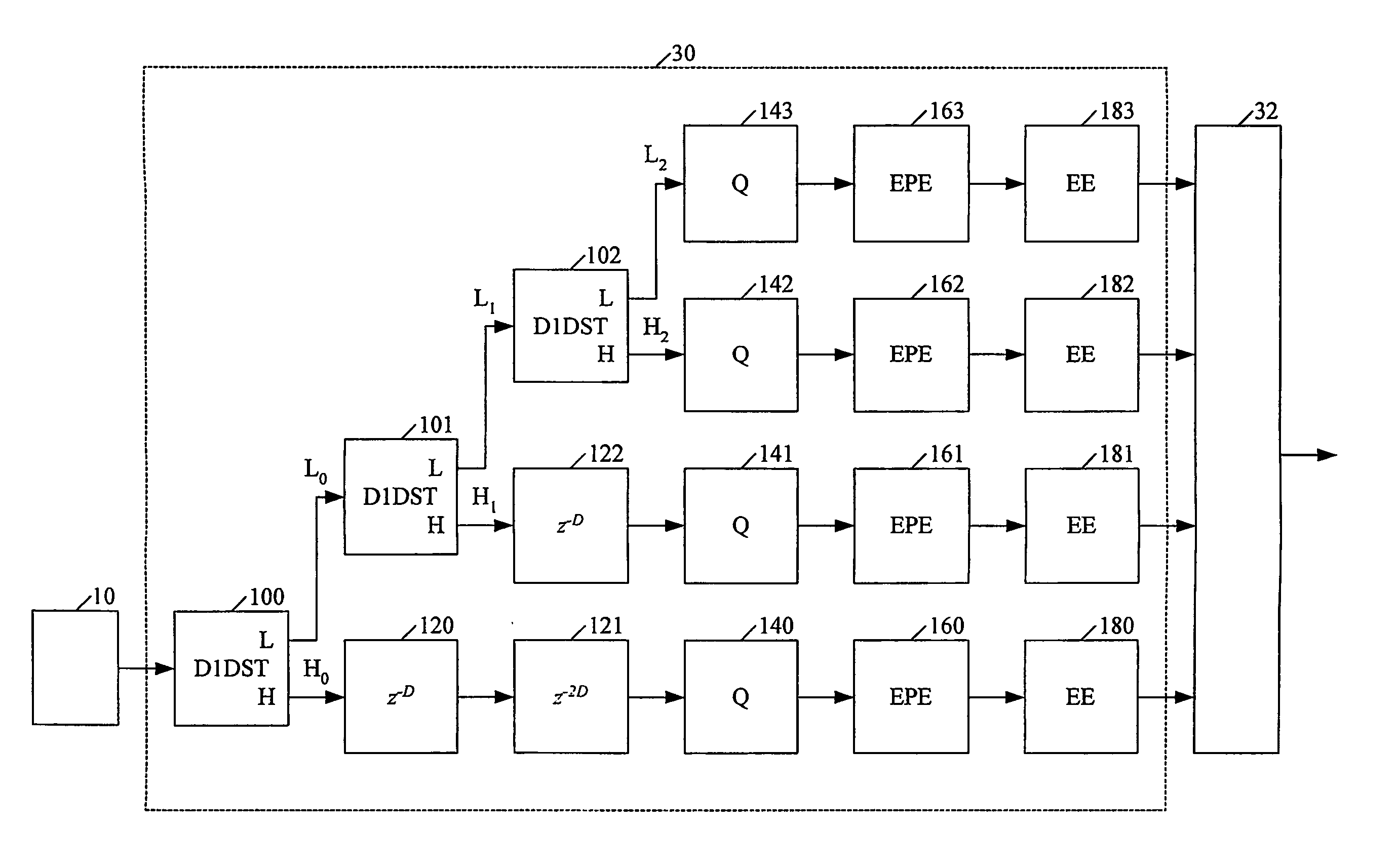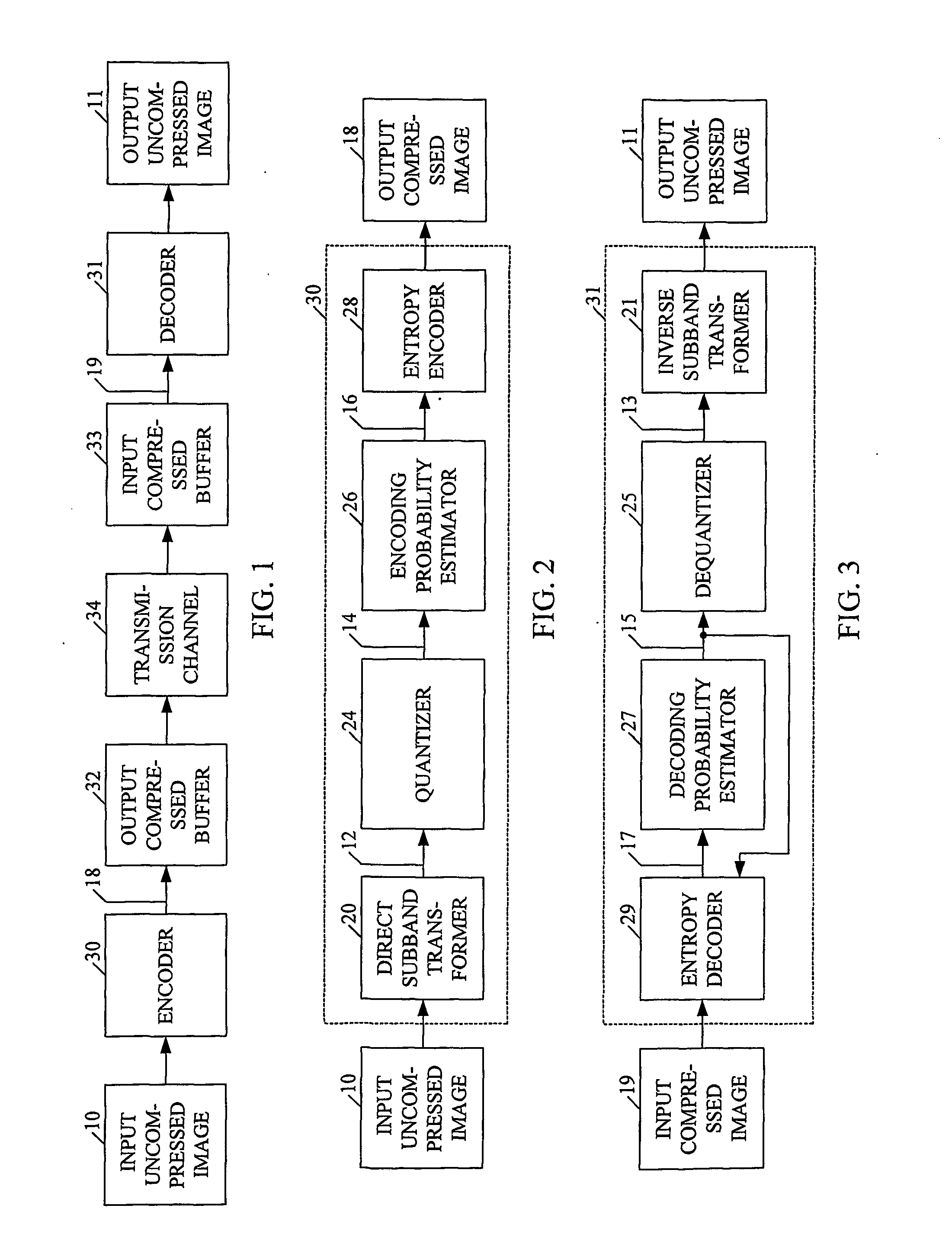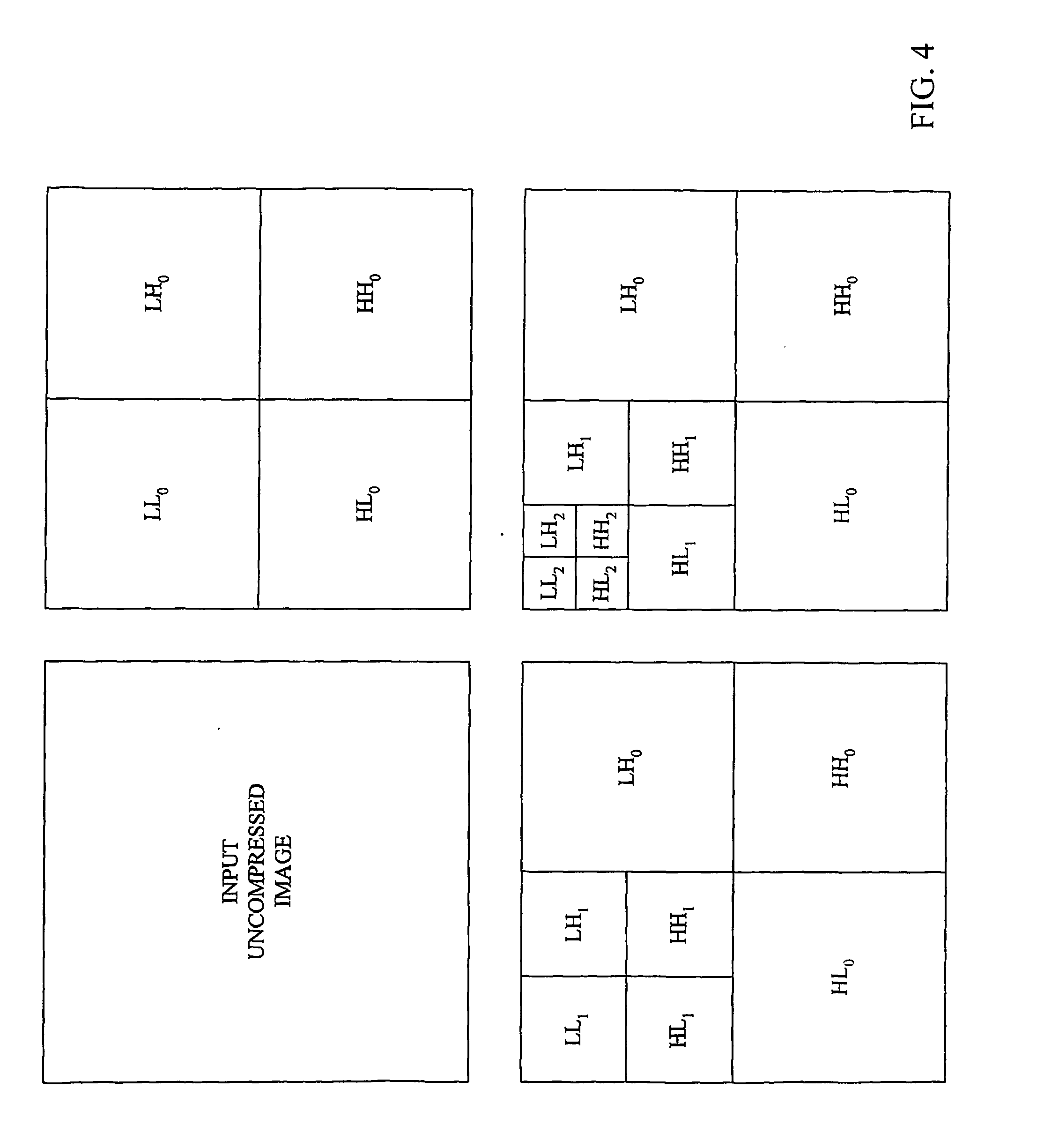Fast codec with high compression ratio and minimum required resources
a codec and compression ratio technology, applied in the field of data compression and decompression methods and apparatuses, can solve the problems of blocking artifacts at high compression ratios, direct coding using entropy coders that cannot achieve satisfactory compression ratios, and human visual systems are very sensitive to such type of image distortion. , to achieve the effect of fast adaptation
- Summary
- Abstract
- Description
- Claims
- Application Information
AI Technical Summary
Benefits of technology
Problems solved by technology
Method used
Image
Examples
first embodiment
[0096]FIG. 9 and FIG. 10 are block diagrams of the encoder 30 and the decoder 31 of this invention, with N=3 levels of D1DST and I1DST, respectively.
TABLE 62DSTTotal synchronization memory size per subband [coefficient]levelSynchronization memory size for 3 subbands (LH, HL and HH) is 3 times higher0(D+2·D+22·D+…+2N-2·D)·W2=W2·∑k=0N-22k·D=(2N-1-1)·D·W21(D+2·D+22·D+…+2N-3·D)·W4=W4·∑k=0N-32k·D=(2N-2-1)·D·W42(D+2·D+22·D+…+2N-4·D)·W8=W8·∑k=0N-42k·D=(2N-3-1)·D·W8n(D+2·D+22·D+…+2N-m-2·D)·W2n+1=W2n+1·∑k=0N-n-22k·D=(2N-n-1-1)·D·W2n+1N-3(D+2·D)·W2N-2=3·D·W2N-2N-2D·W2N-1All levels∑n=0N-2(2N-n-1-1)·D·W2n+1=13·(2N-3+12N-1)·D·WAll levels and all subbands3·∑n=0N-2(2N-n-1-1)·D·W2n+1=(2N-3+12N-1)·D·W
[0097] Instead of buffering the transformation coefficients in the synchronization memory of the encoder 30, input uncompressed data are direct subband transformed in D1DSTs 100-102, using direct non-stationary filters, transformation coefficients are quantized in quantizers 140-143, the probabili...
second embodiment
[0103]FIG. 13 and FIG. 14 are block diagrams of the encoder 30 and the decoder 31 of this invention, with N=3 levels of D1DST and I1DST, respectively.
[0104] Instead of buffering the compressed transformation coefficients in the synchronization memory of the encoder 30, input uncompressed data is direct subband transformed in D1DSTs 100-102, using direct non-stationary filters, transformation coefficients are quantized in quantizers 140-143, the probabilities of transformation coefficients within the specified contexts are estimated in the encoding probability estimators 160-163, the quantized transformation coefficients are entropy encoded in the entropy encoders 180-183 and finally in theirs compressed form stored into the output compressed buffer 32, which temporarily serves as the synchronization memory, from which they will be transmitted.
[0105] Instead of buffering the compressed transformation coefficients in the synchronization memory of the decoder 31, input compressed data...
third embodiment
[0127]FIG. 27 is a block diagram of the direct non-stationary filter of this invention, made of sequentially connected four first-order direct NSFCs: F4=F−1,−1,[α],[α] (x, c) 1020, F5=F−1,−1,[β],[β](x,c) 1021, F6=F1,1,[γ],[γ](x,c) 1022 and F7=F1,1,[Δ],[Δ](x,c) 1023, with parameters given in the TABLE 8.
[0128]FIG. 28 is a block diagram of the third embodiment of the inverse non-stationary filter of this invention, made of sequentially connected four first-order direct NSFCs: F7−1=F−1,−1,[Δ],[Δ](x,c) 1033, F6−1=F−1,−1,[γ],[γ](x,c) 1032, F5−1=F1,1,[β],[β](x,c) 1031 and F4−1=F1,1,[α],[α](x,c) 1030, with parameters given in the TABLE 8.
TABLE 8ParameterValueα1.58193248659365β0.07167834102835γ0.82577375069311Δ0.52307224508739G10.76323962993937G21.31020450298084
[0129] It should be also noticed that all filter embodiments use a symmetrical extension of input data at the image boundaries. However, it is possible to implement non-stationary filter coefficients near image boundaries, in order...
PUM
 Login to View More
Login to View More Abstract
Description
Claims
Application Information
 Login to View More
Login to View More - R&D
- Intellectual Property
- Life Sciences
- Materials
- Tech Scout
- Unparalleled Data Quality
- Higher Quality Content
- 60% Fewer Hallucinations
Browse by: Latest US Patents, China's latest patents, Technical Efficacy Thesaurus, Application Domain, Technology Topic, Popular Technical Reports.
© 2025 PatSnap. All rights reserved.Legal|Privacy policy|Modern Slavery Act Transparency Statement|Sitemap|About US| Contact US: help@patsnap.com



